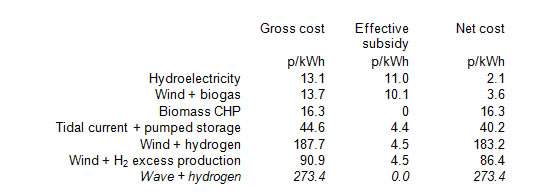Data Centres and Renewable Energy Project


Estimating the costs of energy
As a reality check we estimated the relative costs of each energy option to see whether they are economically feasible relative to buying electricity from the grid. The estimates are order of magnitude only but they should provide insights on how the various options compare to each other.
Outcomes:
The cost per unit energy used by the data centre are given below. Subsidies in this case are Feed-In Tariffs (FITs), which became effective on 1 April 2010 (1). The subsidy is that applied to on-site use of generated electricity.

If a commercial user pays around 10p/kWh for electricity from the grid, then under current circumstances two renewable energy options are economically attractive for a small scale data centre, as they have moderate costs and a high level of FITs:
- Hydroelectricity, if there is a suitable catchment area, within about 15km of a road where the data centre can be sited. Each additional km of transmission line adds 0.5p per kWh.
- Wind with biogas: anaerobic digestion not only attracts Feed-In Tariffs, it can also earn revenue in the form of gate fees and sales of substrate.
At a larger scale, tidal current with pumped storage is likely to become economic in the future. As tidal current turbines start to become manufactured commercially the capital cost will fall. Feed-In Tariffs will eventually be introduced to encourage development (1) and if they start at a similar level to Solar PV today (29.3p/kWh) then this option could be competitive.
It is much harder to see how wind with hydrogen storage could become economic given the enormous cost of hydrogen technology. In the balanced option, storage represents 92% of the gross costs; even with excess wind capacity the storage costs are still two-thirds of the total.
Wave + hydrogen estimates are based on assuming the same load factor and hydrogen storage as for the case of wind + hydrogen. In this case both the primary power supply and the storage are both expensive.
Assumptions and data sources:
Primary energy
Capital and operating costs are based on the Quantitative Analysis for small-scale renewables that formed the basis for setting the level of FITs (2). The exception was Hydroelectricity, where the British Hydroelectric Association’s database of actual costs shows capital costs around one-third higher than the DECC study indicated (3). Capital costs for wave energy devices are for a shoreline device (2) and using the same load factor as for wind.
Life of facility: 50 years for hydroelectricity – average for civils works & turbines
25 years for wind – current standard
15 years for biomass CHP – based on conversations with
10 years for marine current and wave – difficult environment, technology not tested yet
Storage
- Anaerobic digester capital and operating costs and revenues are as given by the National Non-Food Crop Centre’s economic estimator (4);
- Pumped storage costs are based on the BHA database (3) but with an additional 50% to cover additional civil engineering costs
- Hydrogen costs are based on a quotation supplied by Tropical SA (5) and from estimates in a past MSc project (6)
Life of facility: 50 years for pumped storage
25 years for wind – current standard
10 years for biogas and Hydrogen
Transmission
Costs of underground transmission lines per km based on suppliers’ quotes (7)
Distance:
1. Data centre should be sited as close as possible to the energy source to reduce transmission losses and cable costs.
2. Assume 11kV cable over a nominal 0.5km distance in each case, expect for those below.
3. Longer distance and 33kV cable is required for:
- Tidal and pumped storage, where the pumped storage scheme is 5km from the data centre/ landfall for the marine cable
- Hydroelectric, where the data centre would be sited on a two-carriageway road, and the turbine is in the hills 15km away
Lifetime of equipment: 25 years
Other costs
Cost of woodchip based on quotation for delivery of wood pellets from Invergordon to Inverness, and assuming that woodchip is about a third of the cost of pellets. The £50/te used is likely to be on the low side if delivery distances are longer (8).
Subsidies: Feed-In Tariffs as applicable from 1 April 2010 (1); our interpretation was that on-site generation tariffs will be available whether or not the facility was connected to the grid.
Cost of capital: 8% per year
A more detailed presentation of assumptions and calculations are in this spreadsheet
References used in this page:
(1) DECC 2010: Feed-in Tariffs: Government’s Response to the Summer 2009 Consultation, Dept of Energy & Climate Change, February 2010
(2) DECC 2009: Design of Feed-in Tariffs for Sub-5MW Electricity in Great Britain Quantitative analysis for DECC, Element Energy / Pyory for Dept of Energy & Climate Change, URN 09D/704, July 2009
(3) BHA database of small hydroelectric schemes, 2010
(4) National Non-Food Crop Centre Calculator http://www.nnfcc.co.uk/metadot/index.pl?id=7197&isa=DBRow&field_name=file&op=download_file , accessed 17 April 2010
(5) Tropical SA quote: http://www.tropical.gr/siten/index.php?option=com_frontpage&Itemid=1 accessed 15 April 2010 (7) Robertson thesis
(6) Robertson, G 2009: Wind-Hydrogen Community on the Isle of Lewis MSc Thesis, University of Strathclyde
(7) Suppliers’ quotation for Small Scale Hydroelectric Project, MSc Project 2010, University of Strathclyde
(8) Personal communication by engineer from Buccleuch Environmental Services, during site visit to Queen Margaret University 1.5MW Biomass boiler, 24 February 2010